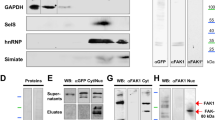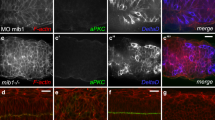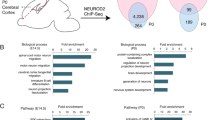Abstract
To understand the function of Notch in the mammalian brain, we examined Notch1 signaling and its cellular consequences in developing cortical neurons. We found that the cytoplasmic domain of endogenous Notch1 translocated to the nucleus during neuronal differentiation. Notch1 cytoplasmic-domain constructs transfected into cortical neurons were present in multiple phosphorylated forms, localized to the nucleus and could induce CBF1-mediated transactivation. Molecular perturbation experiments suggested that Notch1 signaling in cortical neurons promoted dendritic branching and inhibited dendritic growth. These observations show that Notch1 signaling to the nucleus exerts an important regulatory influence on the specification of dendritic morphology in neurons.
This is a preview of subscription content, access via your institution
Access options
Subscribe to this journal
Receive 12 print issues and online access
$209.00 per year
only $17.42 per issue
Buy this article
- Purchase on Springer Link
- Instant access to full article PDF
Prices may be subject to local taxes which are calculated during checkout









Similar content being viewed by others
References
Greenwald, I. & Rubin, G. M. Making a difference: the role of cell–cell interactions in establishing separate identities for equivalent cells. Cell 68, 271–281 (1992).
Ghysen, A., Dambly-Chaudiere, C., Jan, L. Y. & Jan, Y. N. Cell interactions and gene interactions in peripheral neurogenesis. Genes Dev. 7, 723–733 ( 1993).
Artavanis-Tsakonas, S., Matsuno, K. & Fortini, M. E. Notch signaling. Science 268 , 225–232 (1995).
Kimble, J. & Simpson, P. The lin-12/Notch signaling pathway and its regulation. Annu. Rev. Cell Dev. Biol. 13, 333–361 (1997).
Greenwald, I. Lin-12/Notch signaling: lessons from worms and flies. Genes Dev. 12, 1751–1762 ( 1998).
Pan, D. & Rubin, G. M. Kuzbanian controls proteolytic processing of Notch and mediates lateral inhibition during Drosophila and vertebrate neurogenesis. Cell 90, 271 –280 (1997).
Blaumueller, C. M., Qi, H., Zagouras, P. & Artavanis-Tsakonas, S. Intracellular cleavage of Notch leads to a heterodimeric receptor on the plasma membrane. Cell 90, 281–291 (1997).
Logeat, F. et al. The Notch1 receptor is cleaved constitutively by a furin-like convertase. Proc. Natl. Acad. Sci. USA 95, 8108–8112 (1998).
Kidd, S., Lieber, T. & Young, M. W. Ligand-induced cleavage and regulation of nuclear entry of Notch in Drosophila melanogaster embryos. Genes Dev. 12, 3728–3740 ( 1998).
Fortini, M. E. & Artavanis-Tsakonas, S. The suppressor of hairless protein participates in notch receptor signaling. Cell 79, 273–282 ( 1994).
Lecourtois, M. & Schweisguth, F. The neurogenic Suppressor of Hairless DNA-binding protein mediates the transcriptional activation of the Enhancer of split Complex genes triggered by Notch signaling. Genes Dev. 9, 2598–2608 (1995).
Jarriault, S. et al. Signalling downstream of activated mammalian Notch. Nature 377, 355–358 ( 1995).
Tamura, K. et al. Physical interaction between a novel domain of the receptor Notch and the transcription factor RBP-J kappa/Su(H). Curr. Biol. 5, 1416–1423 (1995).
Hsieh, J. J. et al. Truncated mammalian Notch1 activates CBF1/RBPJk-repressed genes by a mechanism resembling that of Epstein-Barr virus EBNA2. Mol. Cell. Biol. 16, 952–959 (1996).
Lu, F. M. & Lux, S. E. Constitutively active human Notch1 binds to the transcription factor CBF1 and stimulates transcription through a promoter containing a CBF1–responsive element. Proc. Natl. Acad. Sci. USA 93, 5663–5667 (1996).
Kopan, R., Schroeter, E. H., Weintraub, H. & Nye, J. S. Signal transduction by activated mNotch: importance of proteolytic processing and its regulation by the extracellular domain. Proc. Natl. Acad. Sci. USA 93, 1683–1688 ( 1996).
Struhl, G. & Adachi, A. Nuclear access and action of Notch in vivo. Cell 93, 649– 660 (1998).
Schroeter, E. H., Kisslinger, J. A. & Kopan, R. Notch1 signalling requires ligand-induced proteolytic release of intracellular domain. Nature 393, 382–386 (1998).
Lecourtois, M. & Schweisguth, F. Indirect evidence for Delta-dependent intracellular processing of Notch in Drosophila embryos. Curr. Biol. 8, 771– 774 (1998).
Coffman, C., Harris, W. & Kintner, C. Xotch, the Xenopus homolog of Drosophila notch. Science 249, 1438– 1441 (1990).
Coffman, C. R., Skoglund, P., Harris, W. A. & Kintner, C. R. Expression of an extracellular deletion of Xotch diverts cell fate in Xenopus embryos. Cell 73, 659– 671 (1993).
Chitnis, A., Henrique, D., Lewis, J., Ish-Horowicz, D. & Kintner, C. Primary neurogenesis in Xenopus embryos regulated by a homologue of the Drosophila neurogenic gene Delta. Nature 375, 761–766 ( 1995).
Dorsky, R. I., Rapaport, D. H. & Harris, W. A. Xotch inhibits cell differentiation in the Xenopus retina. Neuron 14, 487– 496 (1995).
Austin, C. P., Feldman, D. E., Ida, J. A. Jr. & Cepko, C. L. Vertebrate retinal ganglion cells are selected from competent progenitors by the action of Notch. Development 121 , 3637–3650 (1995).
Weinmaster, G., Roberts, V. J. & Lemke, G. A homolog of Drosophila Notch expressed during mammalian development. Development 113, 199–205 (1991).
del Amo, F. F. et al. Expression pattern of Motch, a mouse homologue of Drosophila Notch, suggests an important role in early postimplantation mouse development. Development 115, 737– 744 (1992).
Reaume, A. G., Conlon, R. A., Zirngibl, R., Yamaguchi, T. P. & Rossant, J. Expression analysis of a Notch homologue in the mouse embryo. Dev. Biol. 154, 377 –387 (1992).
Weinmaster, G., Roberts, V. J. & Lemke, G. Notch2: a second mammalian Notch gene. Development 116, 931–941 ( 1992).
Lardelli, M., Dahlstrand, J. & Lendahl, U. The novel Notch homologue mouse Notch3 lacks specific epidermal growth factor-repeats and is expressed in proliferating neuroepithelium. Mech. Dev. 46, 123–136 (1994).
Lindsell, C. E., Boulter, J., diSibio, G., Gossler, A. & Weinmaster, G. Expression patterns of Jagged, Delta1, Notch1, Notch2, and Notch3 genes identify ligand-receptor pairs that may function in neural development. Mol. Cell. Neurosci. 8, 14– 27 (1996).
Bettenhausen, B., de Angelis, M. H., Simon, D., Guenet, J. L. & Gossler, A. Transient and restricted expression during mouse embryogenesis of Dll1, a murine gene closely related to Drosophila Delta. Development 121, 2407–2418 (1995).
Lindsell, C. E., Shawber, C. J., Boulter, J. & Weinmaster, G. Jagged: a mammalian ligand that activates Notch1. Cell 80, 909–917 (1995).
Shawber, C., Boulter, J., Lindsell, C. E. & Weinmaster, G. Jagged2: a serrate-like gene expressed during rat embryogenesis. Dev. Biol. 180, 370–376 (1996).
Swiatek, P. J., Lindsell, C. E., del Amo, F. F., Weinmaster, G. & Gridley, T. Notch1 is essential for postimplantation development in mice. Genes Dev. 8, 707– 719 (1994).
Conlon, R. A., Reaume, A. G. & Rossant, J. Notch1 is required for the coordinate segmentation of somites. Development 121, 1533– 1545 (1995).
Lardelli, M., Williams, R., Mitsiadis, T. & Lendahl, U. Expression of the Notch 3 intracellular domain in mouse central nervous system progenitor cells is lethal and leads to disturbed neural tube development. Mech. Dev. 59, 177–190 (1996).
Chenn, A. & McConnell, S. K. Cleavage orientation and the asymmetric inheritance of Notch 1 immunoreactivity in mammalian neurogenesis. Cell 82, 631–641 (1995).
Gonatas, J. O., Gonatas, M. K., Stieber, A. & Fleischer, B. Isolation and characterization of an enriched Golgi fraction from neurons of developing rat brains. J. Neurochem. 45, 497–507 (1985).
Rebay, I., Fehon, R. G. & Artavanis-Tsakonas, S. Specific truncations of Drosophila Notch define dominant activated and dominant negative forms of the receptor. Cell 74, 319–329 (1993).
Schmechel, D. E., Brightman, M. W. & Marangos, P. J. Neurons switch from non-neuronal enolase to neuron-specific enolase during differentiation. Brain Res. 190, 195–214 (1980).
Forss-Petter, S. et al. Transgenic mice expressing β-galactosidase in mature neurons under neuron-specific enolase promoter control. Neuron 5, 187–197 ( 1990).
Shawber, C. et al. Notch signaling inhibits muscle cell differentiation through a CBF1–independent pathway. Development 122, 3765–3773 (1996).
Qi, H. et al. Processing of the Notch ligand Delta by the metalloprotease Kuzbanian. Science 283, 91–94 (1999).
Berezovska, O. et al. Notch1 inhibits neurite outgrowth in postmitotic primary neurons. Neuroscience 93, 433– 439 (1999).
Sestan, N., Artavanis-Tsakonas, A. & Rakic, P. Contact-dependent inhibition of cortical neurite growth mediated by Notch signaling. Science 286, 741–746 (1999).
Giniger, E., Jan, L. Y. & Jan, Y.-N. Specifying the path of the intersegmental nerve of the Drosophila embryo: a role for Delta and Notch. Development 117, 431–440 ( 1993).
Giniger, E. A role for Abl in Notch signaling. Neuron 20, 667–681 (1998).
Fambrough, D., Pan, D., Rubin, G. M. & Goodman, C. S. The cell surface metalloprotease/disintegrin Kuzbanian is required for axonal extension in Drosophila. Proc. Natl. Acad. Sci. USA 93, 13233–13238 (1996).
Threadgill, R., Bobb, K. & Ghosh, A. Regulation of dendritic growth and remodeling by Rho, Rac, and Cdc42. Neuron 19, 625–634 ( 1997).
Thormodsson, F. R., Redmond, L. & Hockfield, S. Identification of nuclear proteins that are developmentally regulated in embryonic rat brain. J. Neurochem. 64, 1919–1927 (1995).
Acknowledgements
We thank Diane Hayward for providing us with CBF1 reporter constructs, Carrie Shawber and Libby Walker for the pCDNA3.FCDN1 plasmid, Donna Nofziger for affinity purification of the 93-4 antisera, Greg Sutcliffe for the NSE-CAT construct, Yuh-Nung Jan, Weimin Zhong and Connie Cepko for discussions and members of the Ghosh lab for comments on the manuscript. This work was supported by NIH grant NS36176 and the Pew Scholars Program (A.G.).
Author information
Authors and Affiliations
Corresponding author
Rights and permissions
About this article
Cite this article
Redmond, L., Oh, SR., Hicks, C. et al. Nuclear Notch1 signaling and the regulation of dendritic development . Nat Neurosci 3, 30–40 (2000). https://doi.org/10.1038/71104
Received:
Accepted:
Issue Date:
DOI: https://doi.org/10.1038/71104
This article is cited by
-
Cdk5-mediated JIP1 phosphorylation regulates axonal outgrowth through Notch1 inhibition
BMC Biology (2022)
-
Integration of GWAS and brain eQTL identifies FLOT1 as a risk gene for major depressive disorder
Neuropsychopharmacology (2019)
-
MHC Class I Molecules and PirB Shape Neuronal Morphology by Affecting the Dendritic Arborization of Cortical Neurons
Neurochemical Research (2019)
-
Temporal downregulation of the polyubiquitin gene Ubb affects neuronal differentiation, but not maturation, in cells cultured in vitro
Scientific Reports (2018)
-
Regulation of striatal dopamine responsiveness by Notch/RBP-J signaling
Translational Psychiatry (2017)



